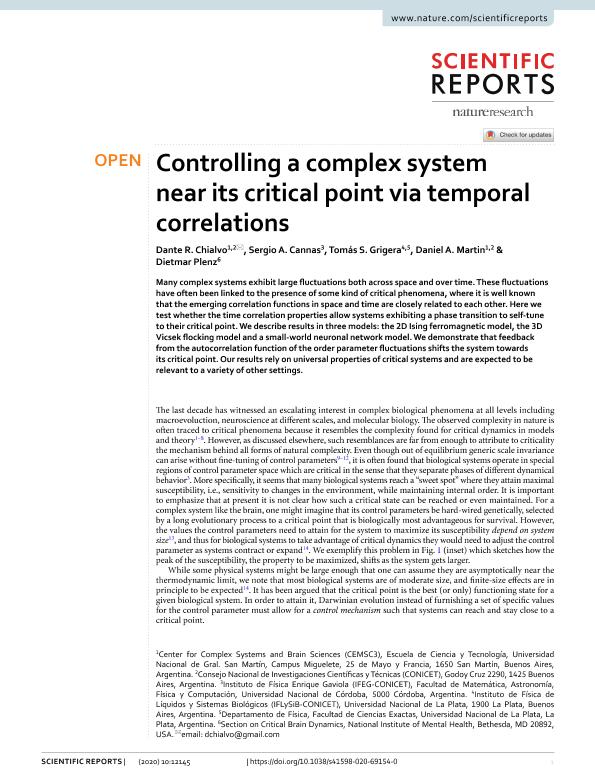Mostrar el registro sencillo del ítem
dc.contributor.author
Chialvo, Dante Renato

dc.contributor.author
Cannas, Sergio Alejandro

dc.contributor.author
Grigera, Tomas Sebastian

dc.contributor.author
Mártin, Daniel Alejandro

dc.contributor.author
Plenz, Dietmar
dc.date.available
2021-09-13T17:56:25Z
dc.date.issued
2020-12
dc.identifier.citation
Chialvo, Dante Renato; Cannas, Sergio Alejandro; Grigera, Tomas Sebastian; Mártin, Daniel Alejandro; Plenz, Dietmar; Controlling a complex system near its critical point via temporal correlations; Nature Publishing Group; Scientific Reports; 10; 1; 12-2020; 1-7
dc.identifier.uri
http://hdl.handle.net/11336/140223
dc.description.abstract
Many complex systems exhibit large fluctuations both across space and over time. These fluctuations have often been linked to the presence of some kind of critical phenomena, where it is well known that the emerging correlation functions in space and time are closely related to each other. Here we test whether the time correlation properties allow systems exhibiting a phase transition to self-tune to their critical point. We describe results in three models: the 2D Ising ferromagnetic model, the 3D Vicsek flocking model and a small-world neuronal network model. We demonstrate that feedback from the autocorrelation function of the order parameter fluctuations shifts the system towards its critical point. Our results rely on universal properties of critical systems and are expected to be relevant to a variety of other settings.
dc.format
application/pdf
dc.language.iso
eng
dc.publisher
Nature Publishing Group

dc.rights
info:eu-repo/semantics/openAccess
dc.rights.uri
https://creativecommons.org/licenses/by/2.5/ar/
dc.subject
CRITICAL PHENOMENA
dc.subject
COMPLEX SYSTEMS
dc.subject
TEMPORAL CORRELATIONS
dc.subject.classification
Otras Ciencias Físicas

dc.subject.classification
Ciencias Físicas

dc.subject.classification
CIENCIAS NATURALES Y EXACTAS

dc.title
Controlling a complex system near its critical point via temporal correlations
dc.type
info:eu-repo/semantics/article
dc.type
info:ar-repo/semantics/artículo
dc.type
info:eu-repo/semantics/publishedVersion
dc.date.updated
2021-09-06T16:44:15Z
dc.identifier.eissn
2045-2322
dc.journal.volume
10
dc.journal.number
1
dc.journal.pagination
1-7
dc.journal.pais
Reino Unido

dc.journal.ciudad
Londres
dc.description.fil
Fil: Chialvo, Dante Renato. Universidad Nacional de San Martín. Escuela de Ciencia y Tecnología; Argentina. Consejo Nacional de Investigaciones Científicas y Técnicas; Argentina
dc.description.fil
Fil: Cannas, Sergio Alejandro. Consejo Nacional de Investigaciones Científicas y Técnicas. Centro Científico Tecnológico Conicet - Córdoba. Instituto de Física Enrique Gaviola. Universidad Nacional de Córdoba. Instituto de Física Enrique Gaviola; Argentina
dc.description.fil
Fil: Grigera, Tomas Sebastian. Universidad Nacional de La Plata. Facultad de Ciencias Exactas. Departamento de Física; Argentina. Consejo Nacional de Investigaciones Científicas y Técnicas. Centro Científico Tecnológico Conicet - La Plata. Instituto de Física de Líquidos y Sistemas Biológicos. Universidad Nacional de La Plata. Facultad de Ciencias Exactas. Instituto de Física de Líquidos y Sistemas Biológicos; Argentina
dc.description.fil
Fil: Mártin, Daniel Alejandro. Universidad Nacional de San Martín. Escuela de Ciencia y Tecnología; Argentina. Consejo Nacional de Investigaciones Científicas y Técnicas; Argentina
dc.description.fil
Fil: Plenz, Dietmar. National Institute of Mental Health; Estados Unidos
dc.journal.title
Scientific Reports
dc.relation.alternativeid
info:eu-repo/semantics/altIdentifier/url/http://www.nature.com/articles/s41598-020-69154-0
dc.relation.alternativeid
info:eu-repo/semantics/altIdentifier/doi/https://doi.org/10.1038/s41598-020-69154-0
Archivos asociados
